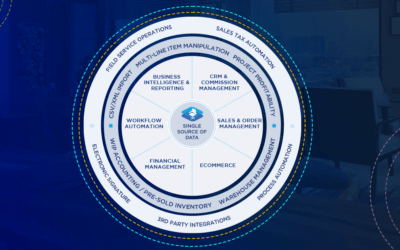Like many industries, the contract furniture sector sits somewhere between still relying on analog business management strategies and adopting new technologies that help them run smarter, better, and faster in today’s ever-changing business landscape. And while the global pandemic and subsequent remote work movement pushed more organizations further down the digital path, many others are still working to formulate their digital roadmaps for the future.
“While contract furniture buyers – from restaurants to offices to airports – have adopted increasingly digitized operations in recent years,” Threekit states in Selling Contract Furniture in Our Increasingly Digital World, “the process of buying contract furniture often remains fairly analog.”
Some furniture suppliers have bucked this trend, but others still rely heavily on manual ways of doing business and managing their back end business processes. This directly impacts furniture dealers that do business with these vendors.
“Admittedly, leaders like Herman Miller and Steelcase offer highly digitized purchase experiences,” Threekit points out, “but smaller vendors typically don’t: hand-drafted quotes, manual spreadsheet updates on the back end, and long sales cycles that rely on in-person visits are the norm.”
Rising Above the Clutter
These realities have created new challenges for an industry that was turned on end when workers left their offices in droves in 2020, and where many plan to stay at least for the foreseeable future. Forced to adapt, many companies in the CFI space sought out creative ways to keep their businesses on track and relevant during this difficult time.
“Needless to say, the past six months haven’t been too kind to office furniture suppliers reliant on corporate customers,” Architectural Digest reports.
“While the realities of COVID-19 turned home office furniture into a growth industry almost overnight,” it continues, “some of the biggest names in traditional office furniture have seen sales plummet at a time when Gallup survey data noted that a majority of Americans preferred the ability to work remotely as much as possible.”
Not CFI’s First Rodeo
A resilient industry that’s been through many economic cycles and customer shifts over the last few decades, the contract furniture sector is stepping up to the plate and coming up with new ways to stay relevant and viable in the current environment.
As part of these efforts, some contract furniture companies have been looking more closely at how cloud-based software and enterprise resource planning (ERP) systems can help them run their businesses more efficiently, effectively, and affordably in the modern business environment.
In a world where salespeople can’t visit clients in person, where manual processes can weigh down even the smallest contract furniture dealers, and where customers have come to expect a digital experience, spreadsheets and phone calls simply don’t cut it anymore.
By replacing spec sheets and hand-drafted quotes with automated and online options; giving salespeople advanced tools to work with; and using an ERP to streamline their back-end systems, furniture vendors and dealers can eliminate some key challenges that they’ve been grappling with for years—and that the pandemic put under a brighter spotlight.
Moving into the Digital World
In one recent industry case study, Siemens highlights how Kimball Hospitality is using digital tools for next-generation product development, including 3D rendering, data management, and product simulation. For example, the manufacturer is creating photo-realistic images and animations from within its modeling environment, and can visualize a product—from communicating a new concept to providing images for sales and marketing.
Kimball is also using Siemens’ software to simulate product appearance, performance, and durability earlier in the design process, make changes when they are easiest, shorten manufacturing times, and reduce manufacturing costs.
“In the past, we used to build three or four, maybe more, prototypes to make sure that a product is going to work,” said a company spokesperson, in the case study. “Now, we use simulation to reduce this number. So, instead of doing five, we do only one. When we get to the real prototype, we’re 99 percent sure that it’s going to work because all of the work is done using simulation.”
Ready, Set, Grow

With the contract furniture industry projected to post a compound annual growth rate (CAGR) of 5.4% over the next five years, Threekit sees good opportunity ahead for companies that embrace the digital landscape and adopt the tools that will help them leverage those opportunities.
“…those projections don’t take into account the many ways contract furniture buyers will likely update their spaces to accommodate new distancing norms,” it adds, “as we return to public spaces, nor the ways individuals are currently furnishing home-based offices.”
Discover CFI Suite | NetSuite for the Contract Furniture Industry

With many contract furniture providers running their businesses on multiple systems and using anywhere from 5 to 10 different pieces of software that aren’t integrated, and that don’t “talk” to one another, there’s ample opportunity to get ahead of the pack by using an integrated technology suite. CFI Suite enables the dealer to manage nearly their entire company on one business system, improving efficiency and scalability, decreasing operational costs and increasing profitability.






